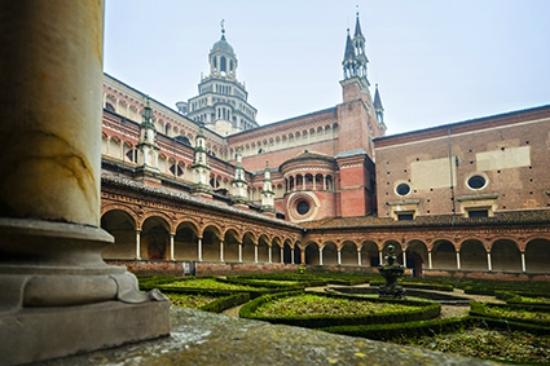Certosa di Pavia
The Certosa di Pavia is a 9 km north of Pavia located, originally built for the Carthusian monastery. It is one of the most important monuments of northern Italy, and is currently inhabited by Cistercian monks.
History
The term is called in German Certosa Certosa.
The building owes its existence to the desire of a wealthy patron, Count Gian Galeazzo Visconti, Duke of Milan, in 1390 to build in the huge park of his castle, a monastery that was to be the tomb of his dynasty at the same time.
The Carthusians devote particular attention to the prayer for one's own and others' salvation. It dictatorial ruling monarch as the Visconti had obviously interested. There are several examples from history that tyrannical rulers and feared the establishment of religious sites supported out of fear of eternal damnation and to improve their public repute to excuse their policies were.
The completion of the monastery lasted long. The façade was only completed in 1549, 150 years after the start of construction.
This renaissance facade of the church of the Madonna delle Grazie is particularly impressive. Your today sighted was designed by Giovanni Antonio Amadeo, her sculptural jewelry with numerous marble figures of Amadeo, Cristoforo Mantegazza and his brother. The ornate church facade has animated art historians all too eulogies. Jacob Burckhardt wrote in his " Cicerone " about it: "In addition to that of the cathedral of Orvieto is the first decorative gem of Italy and the world ... But the immense splendor and partly of fine decorative taste, which dominate the ground floor have a unparalleled in its kind spawned a whole. "
The nave was completed in the mid-15th century. The interior of the monastery church is very quaint and colorful with late Gothic and Renaissance elements designed and hosts several grave times. In particular, the life-sized marble statues of Prince Ludovico il Moro and his deceased at the age of 22 years wife Beatrice d' Este are worth seeing for its realistic representation. The aisles are pulled up, giving the impression of a hall church is created. A look into the vault area shows that work has been done here with a refined sense of color. However, the nave has very small windows and is comparatively dark, which the decorative color can not quite come into its own, it may have the monastic ideals of the Carthusian stood with the pomp will of the Visconti in contradiction to each other.
In the south transept Gian Galeazzo Visconti is buried.
The monastery is a large complex. In the small cloister next to the church is a holy figure in terracotta crowns each column. In the arcades and towers of the church. To the great cloister group the 23 monastic cells. They are arranged as identical houses around the large cloister, each with access to a small private garden. They are partially accessible to visitors today.
Between the Certosa and the nearly 10 km from the castle of Pavia, a garden was created.
The Carthusian monastery was dissolved during the Austrian domination of Lombardy, by the reforms of Joseph II in 1782 and later used alternately as a Cistercian, Carmelite and turn Carthusian monastery. Only since 1968, living in the Cistercian system again.


.jpg)






